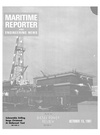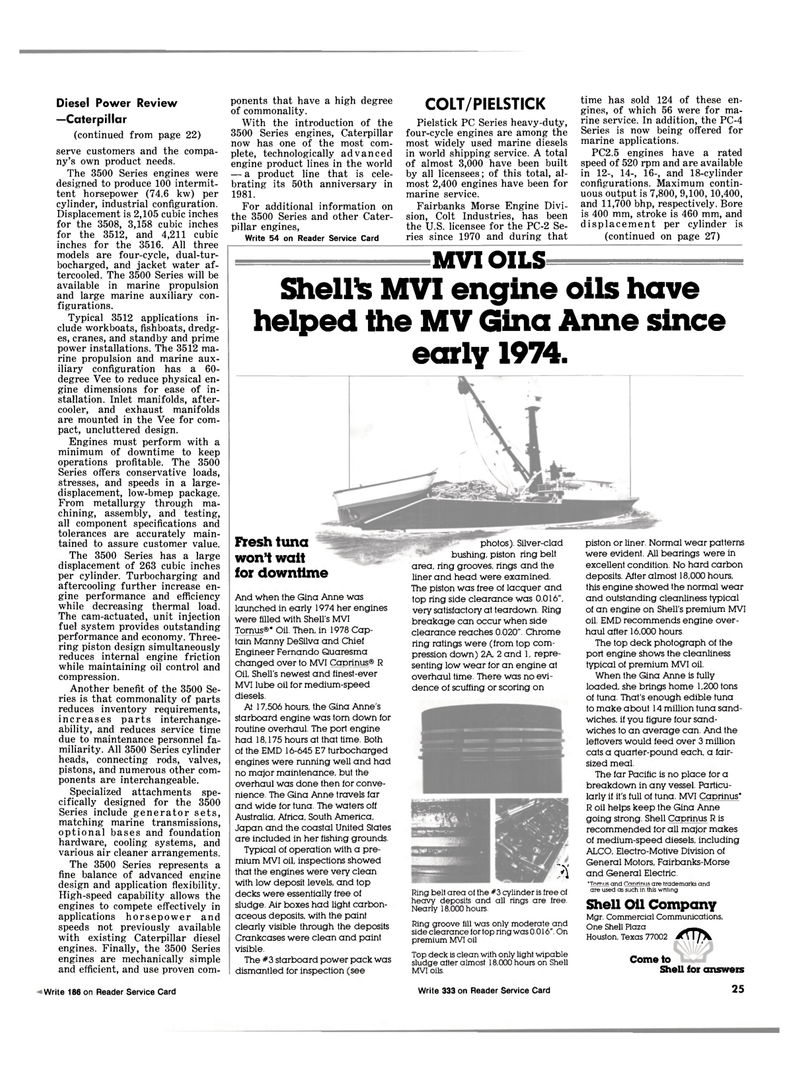
Page 23: of Maritime Reporter Magazine (October 15, 1981)
Read this page in Pdf, Flash or Html5 edition of October 15, 1981 Maritime Reporter Magazine
Diesel Power Review —Caterpillar (continued from page 22) serve customers and the compa- ny's own product needs.
The 3500 Series engines were designed to produce 100 intermit- tent horsepower (74.6 kw) per cylinder, industrial configuration.
Displacement is 2,105 cubic inches for the 3508, 3,158 cubic inches for the 3512, and 4,211 cubic inches for the 3516. All three models are four-cycle, dual-tur- bocharged, and jacket water af- tercooled. The 3500 Series will be available in marine propulsion and large marine auxiliary con- figurations.
Typical 3512 applications in- clude workboats, fishboats, dredg- es, cranes, and standby and prime power installations. The 3512 ma- rine propulsion and marine aux- iliary configuration has a 60- degree Vee to reduce physical en- gine dimensions for ease of in- stallation. Inlet manifolds, after- cooler, and exhaust manifolds are mounted in the Vee for com- pact, uncluttered design.
Engines must perform with a minimum of downtime to keep operations profitable. The 3500
Series offers conservative loads, stresses, and speeds in a large- displacement, low-bmep package.
From metallurgy through ma- chining, assembly, and testing, all component specifications and tolerances are accurately main- tained to assure customer value.
The 3500 Series has a large displacement of 263 cubic inches per cylinder. Turbocharging and aftercooling further increase en- gine performance and efficiency while decreasing thermal load.
The cam-actuated, unit injection fuel system provides outstanding performance and economy. Three- ring piston design simultaneously reduces internal engine friction while maintaining oil control and compression.
Another benefit of the 3500 Se- ries is that commonality of parts reduces inventory requirements, increases parts interchange- ability, and reduces service time due to maintenance personnel fa- miliarity. All 3500 Series cylinder heads, connecting rods, valves, pistons, and numerous other com- ponents are interchangeable.
Specialized attachments spe- cifically designed for the 3500
Series include generator sets, matching marine transmissions, optional bases and foundation hardware, cooling systems, and various air cleaner arrangements.
The 3500 Series represents a fine balance of advanced engine design and application flexibility.
High-speed capability allows the engines to compete effectively in applications horsepower and speeds not previously available with existing Caterpillar diesel engines. Finally, the 3500 Series engines are mechanically simple and efficient, and use proven com- ponents that have a high degree of commonality.
With the introduction of the 3500 Series engines, Caterpillar now has one of the most com- plete, technologically advanced engine product lines in the world — a product line that is cele- brating its 50th anniversary in 1981.
For additional information on the 3500 Series and other Cater- pillar engines,
Write 54 on Reader Service Card
COLT/PIELSTICK
Pielstick PC Series heavy-duty, four-cycle engines are among the most widely used marine diesels in world shipping service. A total of almost 3,000 have been built by all licensees; of this total, al- most 2,400 engines have been for marine service.
Fairbanks Morse Engine Divi- sion, Colt Industries, has been the U.S. licensee for the PC-2 Se- ries since 1970 and during that time has sold 124 of these en- gines, of which 56 were for ma- rine service. In addition, the PC-4
Series is now being offered for marine applications.
PC2.5 engines have a rated speed of 520 rpm and are available in 12-, 14-, 16-, and 18-cylinder configurations. Maximum contin- uous output is 7,800, 9,100,10,400, and 11,700 bhp, respectively. Bore is 400 mm, stroke is 460 mm, and displacement per cylinder is (continued on page 27)
MVI OILS Shells MVI engine oils have helped the M V Gina Anne since early 1974. piston or liner. Normal wear patterns were evident. All bearings were in excellent condition. No hard carbon deposits. Alter almost 18,000 hours, this engine showed the normal wear and outstanding cleanliness typical of an engine on Shell's premium MVI oil. EMD recommends engine over- haul after 16,000 hours.
The top deck photograph of the port engine shows the cleanliness typical of premium MVI oil.
When the Gina Anne is fully loaded, she brings home 1,200 tons of tuna. That's enough edible tuna to make about 14 million tuna sand- wiches, if you figure four sand- wiches to an average can. And the leftovers would feed over 3 million cats a quarter-pound each, a fair- sized meal.
The far Pacific is no place for a breakdown in any vessel. Particu- larly if it's full of tuna. MVI Caprinus"
R oil helps keep the Gina Anne going strong. Shell Caprinus R is recommended for all major makes of medium-speed diesels, including
ALCO, Electro-Motive Division of
General Motors, Fairbanks-Morse and General Electric. 'Tornus and Caprinus are trademarks and are used as such in this wnting
Shell Oil Company
Mgr. Commercial Communications,
One Shell Plaza ^tpp^.
Houston, Texas 77002 d \ TJ\
Come to
Shell for answers
Fresh tuna won't wait for downtime
And when the Gina Anne was launched in early 1974 her engines were filled with Shell's MVI
Tornus®' Oil. Then, in 1978 Cap- tain Manny DeSilva and Chief
Engineer Fernando Quaresma changed over to MVI Caprinus® R
Oil, Shell's newest and finest-ever
MVI lube oil for medium-speed diesels.
Ai 17,506 hours, the Gina Anne's starboard engine was torn down for routine overhaul. The port engine had 18,175 hours at that time. Both of the EMD 16-645 E7 turbocharged engines were running well and had no major maintenance, but the overhaul was done then for conve- nience. The Gina Anne travels far and wide for tuna. The waters off
Australia, Africa, South America,
Japan and the coastal United States are included in her fishing grounds.
Typical of operation with a pre- mium MVI oil, inspections showed that the engines were very clean with low deposit levels, and top decks were essentially free of sludge. Air boxes had light carbon- aceous deposits, with the paint clearly visible through the deposits
Crankcases were clean and paint visible.
The #3 starboard power pack was dismantled for inspection (see photos). Silver-clad bushing, piston ring belt area, ring grooves, rings and the liner and head were examined.
The piston was free of lacquer and top ring side clearance was 0.016", very satisfactory at teardown. Ring breakage can occur when side clearance reaches 0.020". Chrome ring ratings were (from top com- pression down) 2A 2 and 1, repre- senting low wear for an engine at overhaul time. There was no evi- dence of scuffing or scoring on
A
Ring belt area of the #3 cylinder is free of heavy deposits and all rings are free.
Nearly 18,000 hours.
Ring groove fill was only moderate and side clearance for top ring was 0.016". On premium MVI oil
Top deck is clean with only light wipable sludge after almost 18,000 hours on Shell
MVI oils.
Write 186 on Reader Service Card Write 333 on Reader Service Card 25

 22
22

 24
24
